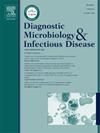rezafungin分离物验证面板的建立及参考方法与ThermoFisher Sensititre YeastOne面板MIC结果的比较
IF 1.8
4区 医学
Q3 INFECTIOUS DISEASES
Diagnostic microbiology and infectious disease
Pub Date : 2025-09-06
DOI:10.1016/j.diagmicrobio.2025.117100
引用次数: 0
摘要
Rezafungin适用于治疗念珠菌病和侵袭性念珠菌病的有限或没有替代治疗方案的成人。描述了一种rezafungin分离物验证面板的开发。初步检测35株念珠菌,后续检测30株念珠菌,包括白色念珠菌(11株)、光滑念珠菌(8株)、热带念珠菌(7株)和拟裂念珠菌(4株)。计算模态MIC、结果范围和绝对一致性结果(基于模态MIC可接受的±2稀释)。FDA STIC和CLSI断点均应用于计算的分类一致性。重复参考BMD (rBMD) MIC结果平均在2.4倍稀释范围内,26/30株(86.7%)的rBMD在±1倍稀释范围内,所有菌株(100%)的rBMD在±2倍稀释范围内。最后的分离物面板用于比较rBMD MIC值与使用Sensititre™YeastOne™面板产生的值。yastone结果与模态rBMD结果的相关性特别好;30株中26株(86.7%)的rBMD在±1倍稀释范围内,100%在±2倍稀释范围内。当使用CLSI和FDA断点计算分类一致性时,CLSI标准的表现优于FDA,尽管这与在断点附近具有MIC结果的有限数量的分离株有关。当实验室将含有rezafungin的测试设备纳入其酵母敏感性测试范式时,具有rezafungin模态MIC值的管理验证小组的可用性将是一个宝贵的资源。本文章由计算机程序翻译,如有差异,请以英文原文为准。
Development of a rezafungin isolate verification panel and comparison of reference method to ThermoFisher Sensititre YeastOne panel MIC results
Rezafungin is indicated for the treatment of adults with limited or no alternative treatment options for candidemia and invasive candidiasis. The development of a rezafungin isolate verification panel is described. A total of 35 Candida species isolates were chosen for initial testing and 30 isolates were selected for additional testing including C. albicans (n = 11), C. glabrata (n = 8), C. tropicalis (n = 7) and C. parapsilosis (n = 4). Modal MIC, range of results and categorical agreement results (based on an acceptable ±2 dilution from the modal MIC) were calculated. Both FDA STIC and CLSI breakpoints were applied to calculated categorical agreement. The replicate reference BMD (rBMD) MIC results spanned an average of 2.4-dilution range and were within ±1 dilution of the modal rBMD for 26/30 (86.7 %) isolates and within ±2 dilutions for all isolates (100 %). The final panel of isolates was used to compare rBMD MIC values with those generated using the Sensititre™ YeastOne™ panel. The correlation of YeastOne results to modal rBMD results was particularly good; 26 out of 30 isolates (86.7 %) were within ±1 dilution of the modal rBMD and 100 % were within ±2 dilutions. When categorical agreement was calculated using CLSI and FDA breakpoints, CLSI criteria performed better than FDA, albeit this was associated with a limited number of isolates with MIC results near the breakpoints. The availability of a curated verification panel with rezafungin modal MIC values will be a valuable resource for laboratories as they incorporate testing devices containing rezafungin into their yeast susceptibility testing paradigm.
求助全文
通过发布文献求助,成功后即可免费获取论文全文。
去求助
来源期刊
CiteScore
5.30
自引率
3.40%
发文量
149
审稿时长
56 days
期刊介绍:
Diagnostic Microbiology and Infectious Disease keeps you informed of the latest developments in clinical microbiology and the diagnosis and treatment of infectious diseases. Packed with rigorously peer-reviewed articles and studies in bacteriology, immunology, immunoserology, infectious diseases, mycology, parasitology, and virology, the journal examines new procedures, unusual cases, controversial issues, and important new literature. Diagnostic Microbiology and Infectious Disease distinguished independent editorial board, consisting of experts from many medical specialties, ensures you extensive and authoritative coverage.

 求助内容:
求助内容: 应助结果提醒方式:
应助结果提醒方式:


